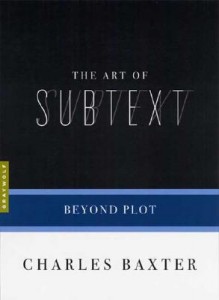The Unspeakable
Baxter, Charles (2007). The Art of Subtext. Minneapolis, MN: Graywolf Press
Subtext is hard to write, because you don’t write it. You set it up and let it show, but it remains unstated. When done effectively, the reader has a sense of discovery far more clear than if the message were stated starkly.
Subtext is mainly found in literary writing. Genre writing tends to state and describe everything, even the obvious. A lot of people like that, and there’s nothing wrong with it. I used to enjoy it, before I started reading literary fiction, and alas, I am now incapable of going back to my formerly beloved mysteries and thrillers.
Married couples are masters of subtext:
“Honey, have you seen my cufflinks?” “I’m not the keeper of your damn cufflinks!”
What’s that about? It’s not about cufflinks. A wife’s one-liner as they head out to a social event: “Is that what you’re wearing?” Woody Allen did a memorable riff on the topic of subtext in the movie, Annie Hall.
Baxter’s book is not exactly an instructional on how to write subtext, but if you think about his examples, you can extract plenty of lessons. The book is more like a set of meditations on subtext, divided into six chapters.
To write good subtext, characters must already be well-known to the reader so that a line of dialog, or a gesture, can carry double meaning. That’s the secret.
One way to do that is to set a scene in a place that defines a mood which can then be used as subtext. Baxter gives plentiful examples from literature to illustrate his points. For example, a woman leaves the room, visibly upset. The man goes to the window she was looking out of and sees the cemetery she saw. He knows then what she was feeling. A meaningful communication has occurred without a word. That technique depends on the characters having a prior history, known to the reader. The past is always a good subtext to the present.
The difference between what a character wants and what they get is rich ground for subtext. The ten-year-old opens his gift and says, “Socks. Thank, you grandma.”
Obsessions are fertile for subtext because they are a compound of mixed motives and emotions. Ahab cannot explain his obsession with the whale. It resists rational discourse. Once we understand that, we can interpret what he says and does in a different way. “This is about the whale, isn’t it?”
A good writer pays attention to how characters fail to pay attention, says Baxter. Willful deafness and misunderstanding are excellent subtext devices. What happens, for example, when a family taboo is finally spoken, yet still goes unheard? Character A makes an emotional and risky confession. Character B replies, “Have you been drinking?”
Baxter describes dozens of techniques for developing subtext, illustrated with examples. The book is a revelation. If only doing it was as easy as understanding how .

